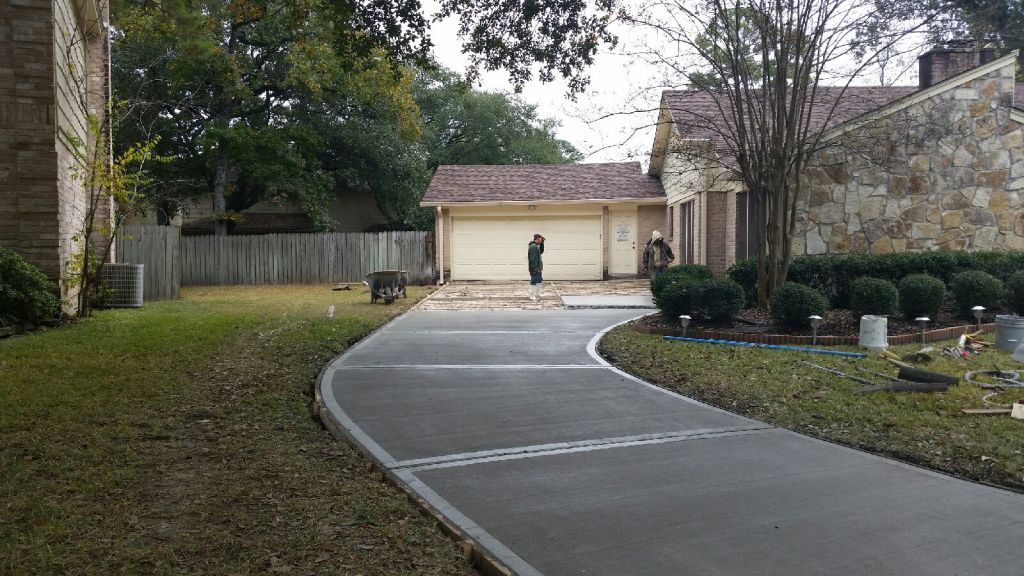Click Here for Specialist Suggestions on Picking the Perfect Concrete Contractor
Click Here for Specialist Suggestions on Picking the Perfect Concrete Contractor
Blog Article
The Environment-friendly Selection: Concrete Sidewalks for Your Neighborhood
Concrete pathways are an ubiquitous feature in most neighborhoods, yet their impact on the environment is frequently neglected. However, picking concrete for your neighborhood pathways can make a substantial difference in terms of sustainability and eco-friendliness. The benefits of going with concrete exceed mere visual appeals and functionality. By taking into consideration the environmental benefits and long-lasting effects on the area, the option of products for walkways becomes an important decision. Allow's check out why concrete pathways may be the environmentally friendly selection your community requires.
Benefits of Concrete Sidewalks
When taking into consideration the installment of sidewalks in a neighborhood, the benefits of picking concrete over various other products are countless and significant. Concrete sidewalks provide toughness, holding up against hefty foot web traffic, climate fluctuations, and ecological components much better than different products like asphalt or crushed rock.

Toughness and Longevity
Exactly how can concrete sidewalks outmatch other products in regards to sturdiness and longevity? Concrete sidewalks are renowned for their remarkable longevity and durability contrasted to alternative materials like asphalt or pavers. The integral strength of concrete makes it extremely immune to cracking, moving, and basic wear and tear triggered by foot web traffic, weather changes, and various other ecological elements. Unlike asphalt, which can soften in heats and split in freezing conditions, concrete keeps its architectural integrity, needing very little upkeep over time.
Concrete walkways likewise have a longer lifespan than pavers, which are susceptible to irregular settling, weed development in between joints, and specific paver activity. The strong, continual surface area of concrete minimizes stumbling hazards and ensures a smooth walking path for pedestrians. Additionally, concrete's sturdiness lowers the need for constant repair work or substitutes, making it a lasting and cost-efficient selection for area pathways. By spending in concrete walkways, areas can appreciate a long-lasting and reliable infrastructure that boosts the total aesthetic allure and capability of the area.
Low Upkeep Requirements
Concrete walkways stand out for their marginal upkeep needs due to their long lasting nature and long-lasting efficiency. Unlike different materials that may need frequent repairs or replacements, concrete sidewalks use a cost-effective remedy that requires little upkeep over time.
Regular upkeep for concrete sidewalks normally entails simple tasks such as routine cleaning to eliminate particles and periodic securing to shield the surface area. In contrast to materials like asphalt or pavers that may shift, crack, or deteriorate more easily, concrete walkways preserve their structural stability with very little intervention. Furthermore, any type of repair work that may be needed are typically localized and can be dealt with swiftly, decreasing both the moment and expense connected with upkeep.

Environmental Benefits
With a concentrate on sustainability and eco-friendliness, concrete walkways provide significant environmental advantages that add to a greener area framework. Concrete is a material known for its sturdiness and longevity, reducing the demand for constant replacements. This longevity decreases the ecological effect related to the production and transportation of brand-new materials for sidewalk building and construction. In addition, concrete walkways have a high solar reflectance index, meaning they mirror a considerable amount of sunshine as opposed to maintaining and absorbing warmth. This high quality aids reduce the city warm island effect, lowering energy intake for cooling structures and enhancing total comfort in city areas.
Moreover, concrete is a permeable material that enables water to penetrate right into the ground, reducing stormwater overflow and helping in groundwater recharge. This aids protect against erosion, reduce flooding, and preserve the all-natural equilibrium of water supply in your area. By choosing concrete sidewalks, communities can make a sustainable option that positively affects the setting and enhances the lifestyle for locals.
Enhancing Area Sustainability
By focusing on sustainable facilities solutions, communities can grow a harmonious balance between environmental awareness and community growth. Enhancing community sustainability includes a complex method that goes beyond simply the environmental benefits of concrete pathways. Implementing eco-friendly spaces, promoting energy-efficient practices, and cultivating a feeling of neighborhood interaction are necessary elements of producing a sustainable neighborhood.
One way to enhance area sustainability is via the combination of permeable concrete sidewalks. These pathways permit rainwater to seep right into the ground, minimizing stormwater overflow and reducing the strain on metropolitan drain systems. legendaryconcretebrentwood.com. By incorporating absorptive walkways, neighborhoods can enhance water quality, lower flooding dangers, and enhance total environmental strength
Moreover, promoting different transportation methods such as strolling and cycling Concrete Contractor can dramatically minimize carbon emissions and advertise a healthier way of living among homeowners. Creating secure pedestrian pathways, bike lanes, and designated greenways can motivate residents to depend less on autos, additionally contributing to the community's sustainability objectives.
Final Thought
Finally, concrete walkways supply various advantages for neighborhoods, including durability, reduced upkeep requirements, and ecological advantages. By selecting concrete sidewalks, neighborhoods can boost their sustainability and contribute to a much more environmentally friendly atmosphere. It is clear that concrete pathways are the perfect selection for areas wanting to enhance their framework in a eco friendly and lasting way.
When taking into consideration the installation of sidewalks in a neighborhood, the benefits of selecting concrete over various other products are numerous and significant. In addition, concrete's longevity decreases the requirement for regular fixings or substitutes, making it a cost-effective and sustainable choice for neighborhood sidewalks (Click Here).With an emphasis on sustainability and eco-friendliness, concrete pathways supply remarkable ecological benefits that add to a greener community facilities. Enhancing community sustainability entails a complex technique that goes past simply the environmental benefits of concrete walkways.In conclusion, concrete sidewalks offer numerous advantages for areas, consisting of longevity, reduced maintenance requirements, and ecological benefits
Report this page